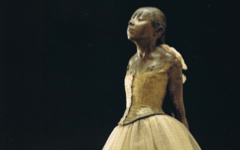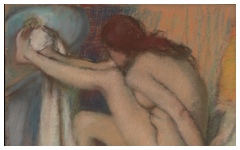Degas’ Edouard Manet at the Races (c.1865)
Edgar Degas' simple but elegant sketch of Edouard Manet attending a horse race was probably intended as a study for some larger painting. Yet while it appears to be an on-site drawing, it is unlikely to be an "accurate" drawing of what Degas saw.

Degas, Edouard Manet at the Races (c.1865) Graphite and black chalk on beige wove paper. Metropolitan Museum, New York
Click image to enlarge.
Edgar Degas' simple but elegant sketch of Edouard Manet attending a horse race was probably intended as a study for some larger painting. Yet while it appears to be an on-site drawing, it is unlikely to be an "accurate" drawing of what Degas saw.
Click next thumbnail to continue

Left: Detail of Degas' Edouard Manet at the Races
Right: Cover of L'Art Moderne magazine with an illustration of Manet on his deathbed (1883)
Click image to enlarge.
Degas may have altered Manet's nose. Here (at left) he drew it with a straight contour even though Manet's nose in life was clearly hooked, as can be seen in a deathbed photograph (right). (Whether Degas adjusted his own nose in self-portraits is discussed in a note below.)1
Click next thumbnail to continue

Top left: Detail of Manet's hand in Degas' Edouard Manet at the Races
Top right: Degas, Detail, inverted and rotated, of Self-portrait (c.1857) Red chalk on paper. National Gallery of Art, Washington DC.
Lower left and right: Diagrams of details above.
Click image to enlarge.
Where in this portrait of Manet, then, is Degas' self-reference? Instead of giving Manet his own concave nose (as he did in a contemporaneous portrait), Degas turned Manet's hand stuck in his jacket pocket (top left) into a veiled self-portrait. Compare it with an actual self-portrait (top right). Degas seems to have used Manet's thumb as his own concave "nose". Some soft shading on a diagonal further up the sleeve suggests his "eye". And a square-ish protrusion of fabric lower down conveys his "chin". "Manet" emerges out of the amorphous form of Degas' imagination: one great master as another.
Click next thumbnail to continue
Manet's prominent thumb (left), like many distended thumbs in art, also refers to the thumb of the palette-hand stretched to fit through the thumb-hole. In addition the palette's traditional partners, brush and mahlstick, are both suggested in a single form: Manet's own stick (right) held next to his chin. Obvious as a stick, the shading lower down its length suggests the hairs of a paintbrush as well with its handle therefore upright.2 Thus the stick is both "mahlstick" and "paintbrush".
Click next thumbnail to continue
Vision and art are the principal subjects. Symbols for paintbrush, mahlstick and palette all line up on the left vertical edge of Manet's figure as though it was a dividing line between the two realities of studio and image. And not only does Manet the master "emerge" from Degas hidden "head" as though a product of Degas' imagination but Degas' veiled head (intellect) is formed from Manet's hand (craft). The woman next to Manet stares back through binoculars at the actual artist drawing "the scene" who, theoretically, stares back at her in a revolving loop. Is she looking at a horse (cheval) or through Degas' easel (chevalet) into his studio? On another level, though, Manet is seen resting his "paintbrush" and "mahlstick" against his chin as he meditates on his unfinished "drawing" of the woman next to him who will now remain as "a drawing" in a state of becoming forever.
For an additional observation, see "How Degas Drew a Top Hat".
Vision and art are the principal subjects. Symbols for paintbrush, mahlstick and palette all line up on the left vertical edge of Manet's figure as though it was a dividing line between the two realities of studio and image. And not only does Manet the master "emerge" from Degas hidden "head" as though a product of Degas' imagination but Degas' veiled head (intellect) is formed from Manet's hand (craft).
More Works by Degas
Is Degas' Little Dancer just a dancer, a study in realism? Or is she......?

Degas’ Little Dancer Aged Fourteen (1879-81)
Notes:
1. Degas tended to depict his own nose in self-portraits as unusually concave, as discussed in another entry, Degas' Portrait of Manet (c.1865). A well-known anti-Semite Degas might even have accentuated this concavity in self-portraits (see examples in the Degas Gallery) because the nose was then considered an indicator of character and the concave type he drew on himself was called the very opposite of the "Jewish" nose. Manet, a non-practising upper middle-class Catholic, appears to have owned a "Jewish" nose, the appearance of which he too may have altered in self-portraits by posing frontally. For the five basic types of nose and their meaning in the mid-19th century, see George Jabet, Notes on Noses (London: Richard Bentley) 1852, esp. p. 11.
2. Manet himself did something similar with a fly-whisk in his etching of an Odalisque (1868).
Original Publication Date on EPPH: 16 Mar 2013. | Updated: 0. © Simon Abrahams. Articles on this site are the copyright of Simon Abrahams. To use copyrighted material in print or other media for purposes beyond 'fair use', you must obtain permission from the copyright owner. Websites may link to this page without permission (please do) but may not reproduce the material on their own site without crediting Simon Abrahams and EPPH.




